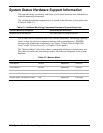
8 Glossary
ROM
(Read-Only Memory) A type of memory device that usually is used to store system BIOS
code. This code cannot be altered and is not lost when the computer is powered off. See
also BIOS, EPROM, and flash EPROM.
RS-232C port
An industry standard serial port. See also serial port.
S
SAF-TE
(SCSI Accessed Fault Tolerant Enclosure) A specification for monitoring the state of the
drives and enclosure environment (fan, power supply, temperature, etc.) using the SCSI bus
to indicate faults.
save
To store information on a floppy disk, hard disk, magnetic tape, or some other permanent
storage device.
SCSI
(Small Computer System Interface) An industry standard interface that provides high-speed
access to tape drives, hard disk drives, and other peripheral devices.
SEL
(System Event Log) A record of system management events. The information stored
includes the name of the event, the date and time the event occurred and data pertinent to
the event. Event data may include POST error codes that reflect hardware errors or software
conflicts within the system.
serial communication
Information sent sequentially, one bit at a time.
serial port
The connector on the back of your computer that allows the transfer of data between the
computer and a serial device, such as a mouse, a modem, or a serial printer.
setup program
The program that you use to change the configuration of some ISA desktop and notebook
computers. This program also contains information about the hardware in the computer.
software
Programs with specific functions, such as word processing, data base management,
communications, and operating system.
SRAM
(Static RAM) A temporary storage area for data and programs. This type of memory does
not need to be refreshed, but it is lost when the computer is powered off. See also NVRAM
and RAM.


















